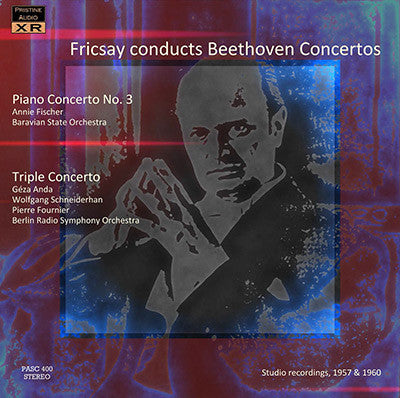
- Producer's Note
- Full Track Listing
- Cover Art
Fricsay a masterful maestro with brilliant soloists Fischer, Anda, Schneiderhan & Fournier
"This would be my own choice" - "I have never heard it better played" - The Gramophone, 1961
Both of these recordings were essentially very well made, and these new transfers have, with XR remastering, built on very fine originals a clean, clear and full sound that in both cases might have been recorded just last week, rather than more than fifty years ago. One problem did rear its head in the second movement of the piano concerto, where cuts between takes caused considerable jumps in the stereo soundstage's intended centre image. These I have attempted to ameliorate as much as possible, though the careful listener on headphones may still spot the joins.
That said, this is unlikely to detract from these wonderful performances and recordings.
-
BEETHOVEN Piano Concerto No. 3 in C minor, Op. 37
Recorded 3 December, 1957
Herkulesaal, Munich
Issued as DGG SLPM 138087
Annie Fischer, piano
Bavarian State Orchestra
-
BEETHOVEN Triple Concerto in C major, Op. 56
Recorded 1 May, 1960
Jesus Christus-Kirche, Berlin
Issued as DGG SLPM 136236
Géza Anda, piano
Wolfgang Schneiderhan, violin
Pierre Fournier, cello
Berlin Radio Symphony Orchestra
- *MOZART Concert Rondo in D, K.382
- *MOZART Concert Rondo in A, K.386
Herkulesaal, Munich
Issued as DGG SLPM 138087
Annie Fischer, piano
Bavarian State Orchestra
Ferenc Fricsay, conductor
*Download only: due to lack of space on the CD disc, these tracks are download-only. They are included in all downloads.
Fanfare Review
A memento of treasurable artists at their very best.
Combining two Beethoven concerto
recordings by Ferenc Fricsay is a splendid idea. As we know from his
striking and individual “Eroica” in his Great Conductors of the 20th Century
set, Fricsay is a Beethoven conductor of passion and brilliance. His
Third Piano Concerto with Annie Fischer is a great recording. The two
Hungarians have a heightened rapport with each other. Fricsay’s opening
tutti in the first movement is vigorous and lyrical at the same time,
with a contrast of light and shade as in an etching. Fischer takes up
this mood with a big but beautifully articulated sound. She employs just
enough rubato to give the music a sense of flow. The movement is
absolutely con brio,
with Fischer and Fricsay creating drama even in quiet moments. Her
cadenza is an immense accomplishment, exhibiting the quality of the
improvisations Beethoven was famous for. Fischer establishes a rapt mood
at the start of the Largo.
As the movement proceeds, her playing acquires the charm appropriate to
a light, romantic episode. Fricsay’s accompaniment is full of subtle
colors. The Rondo begins with the music being propelled along, though
with no heavy-handedness. Fischer’s playing sparkles. The music making
here combines depth with energy. The coda is like a gemstone in a
perfect setting.
The recording of the Triple Concerto is
justly famous. Fricsay sets a spacious tempo at the start that brings
out the majesty of the opening movement. The exchanges between the
soloists are civilized and gently Romantic. Schneiderhan and Fournier
could not play more elegantly. Anda’s contribution here is more
propulsive and agitated, what we think of as traditionally Beethovenian.
In the Largo,
Fournier’s entrance is the stuff of legends. The trio blends
beautifully, taking the lead away from Fricsay. The concluding Rondo
possesses a winsome quality. Schneiderhan plays with a gloriously
singing tone. The development section’s Polish rhythms are brought out
by all concerned. The work’s conclusion has dash, élan, and, what’s
more, wit. I have the LP of this recording, so I was able to hear what
Other renditions I like of the Third Concerto are the remastered version by Alfred Brendel with James Levine, which I prefer to Brendel’s final recording with Simon Rattle, and the CD by Peter Rösel with Claus Peter Flor. Karajan’s disc of the Triple Concerto with Richter, Oistrakh, and Rostropovich certainly is the equal or greater of Fricsay’s, not least for the increased intimacy in the Russians’ playing. I once heard a gorgeous account of the Triple Concerto in concert with the Kalichstein-Laredo-Robinson Trio and the New Jersey Symphony, Jaime Laredo demonstrating remarkable conductorial control over the orchestra while playing his solos. If you don’t know the Fricsay recordings of these concertos, by all means get this CD. It is a memento of treasurable artists at their very best.
Dave Saemann
This article originally appeared in Issue 37:5 (May/June 2014) of Fanfare Magazine.

